Search has changed a lot over the past few years
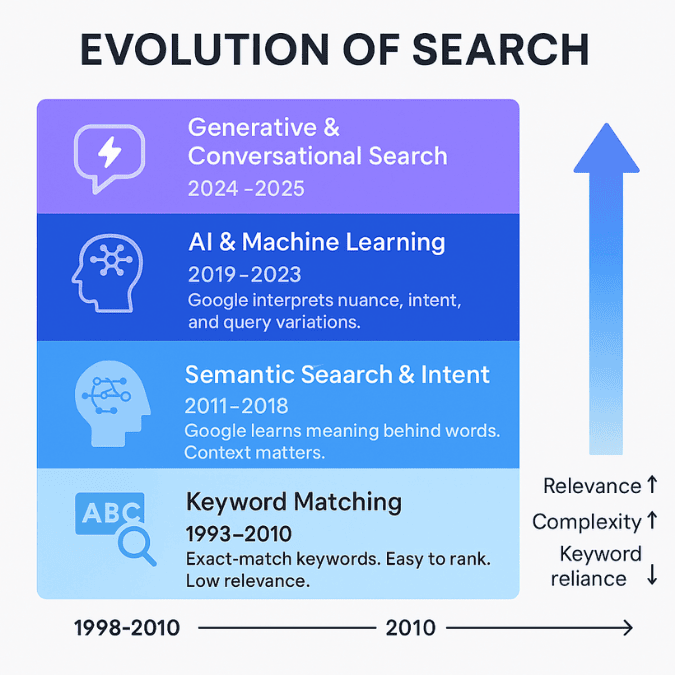 And in 2025, SEO isn’t just about keywords — it’s about visibility, trust, and making sure the right people find you before your competitors do.
And in 2025, SEO isn’t just about keywords — it’s about visibility, trust, and making sure the right people find you before your competitors do.
Whether you’re running a Shopify store, a SaaS business, or a small café in the suburbs, your customers are searching.
And if you’re not showing up? You’re leaving money on the table.
But there’s a big problem:
Most business owners still rely on outdated tactics — or skip SEO entirely.
They either get overwhelmed or waste money on strategies that don’t move the needle.
This is why I have written this guide to help you make your business visible to your customers in 2025 through SEO
It gives you real SEO tips tailored for your type of business. No jargon. No fluff. Just practical insights you can use (or hand off to a pro).
By the end, you’ll know:
- What works in 2025 (and what doesn’t)
- How to optimize your site based on your business type
- Where to focus your energy to get more leads, clicks, and conversions
Let’s break it down — starting with the core SEO basics every business owner should know.
What SEO Really Means in 2025
SEO today is smarter than ever.
Google isn’t just matching keywords, it tries to understand context behind the keywords — it’s evaluating content based on:
- Experience (Do you actually know what you’re talking about?)
- Expertise (Are you qualified to give advice?)
- Authority (Do others trust you?)
- Trustworthiness (Is your site secure and reliable?)
(aka EEAT it shows how authoritative you’re regarding the topic)
In short:
If you’re trying to game the algorithm, you’ve already lost.
Google wants to reward real businesses providing REAL value to their Customers
Here’s what that means for you:
- Don’t stuff your pages with keywords (also known as keyword stuffing is a black hat techniques in SEO which is not recommended at all in 2025). Instead, solve real problems with helpful content.
- Focus on creating a great UX or user experience — fast site, clear messaging, and simple navigation.
- Build trust through testimonials, reviews, and useful blog content.
- Be consistent. SEO is a long game — not a one-time task.
I often says it to my fellows
Want to rank in 2025?
Stop thinking like a “marketer”. Start thinking like your “customer”.
SEO Foundations All Business Owners Must Nail
Before we dive into tips by business type, let’s lock in the basics.
Because without a solid foundation, even the best content won’t rank — and won’t convert.
Here are the non-negotiables every business owner needs to get right in 2025:
1. Keyword Research That Aligns with Intent
Most people pick keywords based on search volume.
That’s a mistake.
In 2025, your focus should be search intent (Also known as user intent) means — what the user actually wants when they search.
There are four types of main search intent
- Informational (want to know something)
- Commercial (User’s are investigating)
- Transactional (Ready to buy)
- Navigational (User searching a particular site)
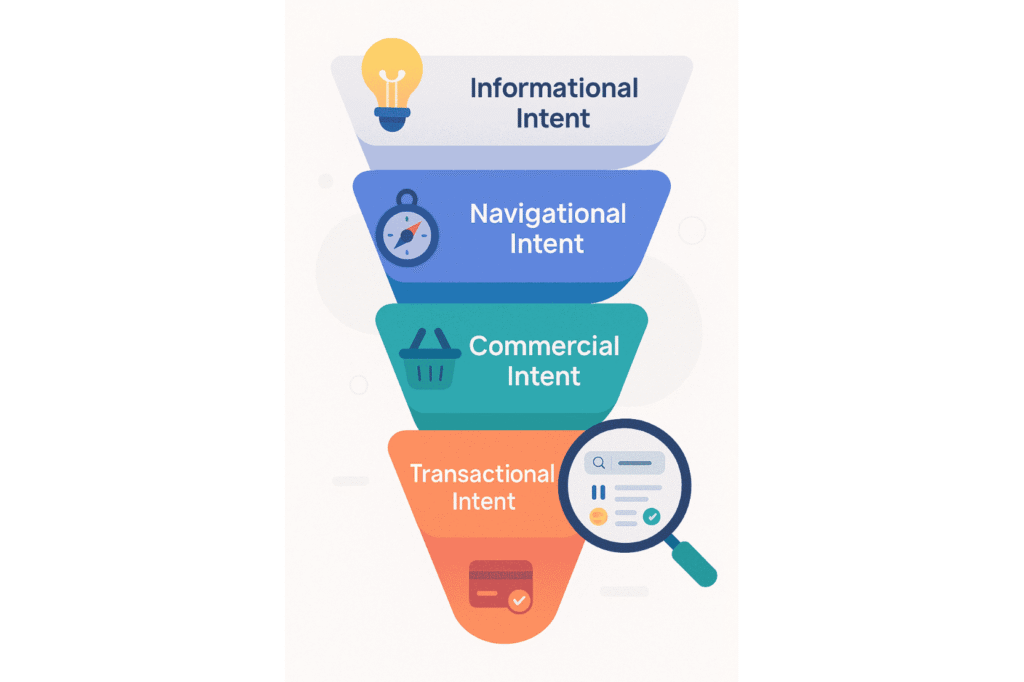
That being said:
- Use keywords that match what your buyer is looking for (e.g. “emergency electrician in London” vs. just “electrician”)
- Don’t chase high-volume phrases that won’t convert
- Tools to try: Google Search Console, AnswerThePublic, Ahrefs, LowFruits
Look for “problem-solving” keywords — they drive the best traffic and leads.
2. On-Page SEO That Makes Google Smile
This is your site’s hygiene — and skipping it is like showing up to an interview in pajamas. Haha Just kidding. On-page SEO is one of the most important parts of SEO that tells Google and users about your content. Some on-page optimization best practices are-
- Use one H1 tag per page (your main headline)
- Add clear title tags and meta descriptions
- Include your keyword in the first 100 words
- Use internal links to connect your pages
- Write image alt text that describes what’s in the image

Your SEO should guide, not trick.
Structure content so Google and your visitors can understand it fast. The better Google can understand your content the better it can rank.
3. Technical SEO That Just Works
Your site needs to be functional. Fast. Mobile-friendly. Crawlable.
If Google can’t access your content — it won’t rank. As simple as that.
- Fix broken links and redirects
- Submit your sitemap via Google Search Console
- Check site speed (especially mobile)
- Use HTTPS and secure your site
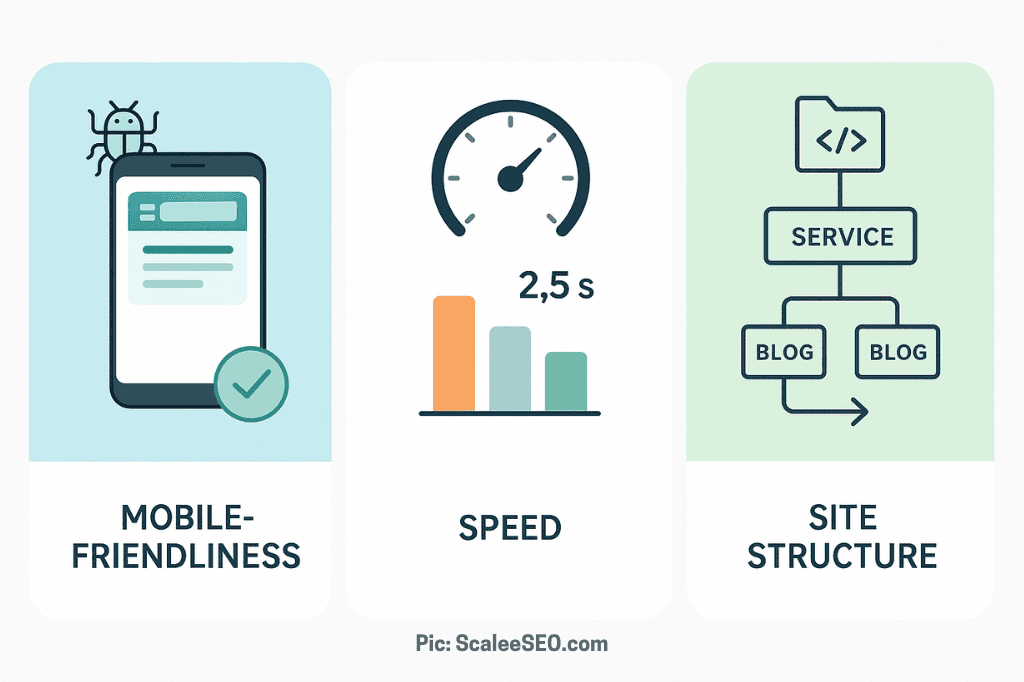
Nobody wants to wait in this speedy era.
Even the best content won’t rank on a slow, messy website. Keep it clean under the hood.
Don’t keep your visitors waiting
4. Backlinks That Actually Matter
Forget spammy link farms.
In 2025, quality > quantity.
You want backlinks from:
- Trusted blogs and media in your industry
- Real directories (not spammy ones)
- Partners, suppliers, collaborators
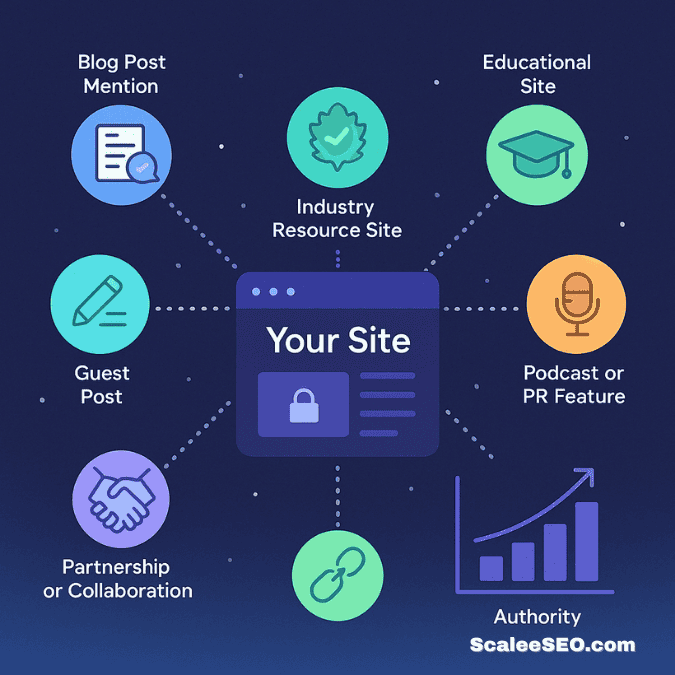
Create content so good that others want to link to it.
5. Content That’s Built to Serve — Not Sell
Content is still king — but only if it’s useful.
- Solve real problems
- Use real-world examples
- Speak in plain language
- Answer the questions your audience is already Googling

Helpful beats clever. Every blog post or landing page should make your reader say, “Wow, that helped.”
When these five foundations are solid, everything else becomes easier.
And if you don’t have time to do this right?
That’s what we’re here for.
At ScaleeSEO, we fix foundations first — so your marketing doesn’t crumble later.
SEO Tips for Small Business Owners
Running a small business is no small task.
You wear 10 hats, handle everything from customer service to sales — and somehow, you’re expected to master SEO too?
Let’s simplify that.
In 2025, local SEO is your golden ticket.
People search with intent:
“plumber near me”
“best bakery in Glasgow”
“emergency electrician open now”
You want to show up before your competitors — and here’s how:
1. Optimise Your Google Business Profile
This is step one — no excuses.
- Add your full business info (name, address, phone, website)
- Upload real photos (interior, exterior, team, services)
- Choose the right category
- Ask happy clients to leave reviews regularly
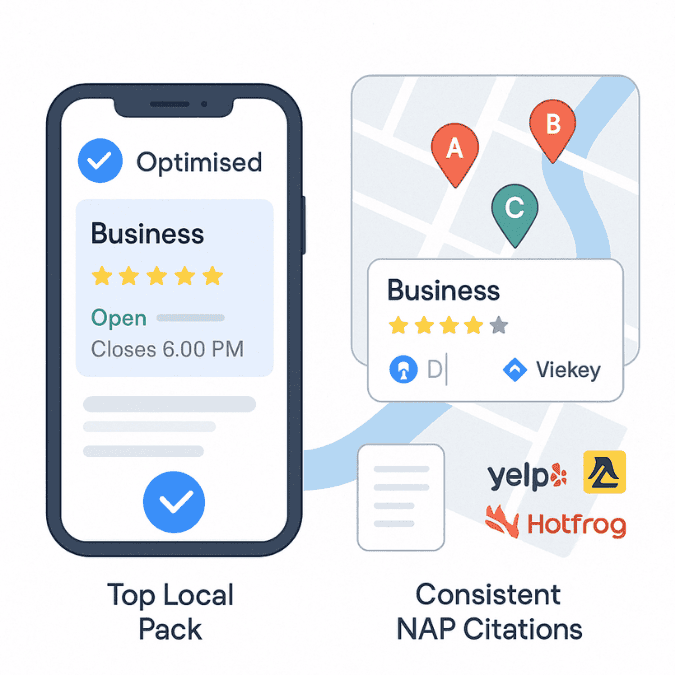
Add posts, offers, and FAQs weekly — it boosts activity and trust.
2. Use Local, Intent-Based Keywords
Don’t just rank. Rank for what people are actually searching for.
- Instead of “photographer,” go for “wedding photographer in Liverpool”
- Tools to try: Google Auto-Suggest, LowFruits, Ubersuggest
Add these keywords naturally to your homepage, service pages, and meta titles.
3. Create Individual Pages for Each Service
Don’t list all your services on one page. Break them down:
/boiler-repair-leeds
/emergency-plumbing-leeds
This tells Google exactly what you do — and where you do it.
Add FAQs, testimonials, and clear CTAs on each service page.
4. Build Local Backlinks and Citations
You don’t need 1,000 backlinks. You need 10 right ones.
- Get listed on directories like Yell, Yelp, Hotfrog, Trustpilot
- Partner with local businesses for mentions
- Sponsor a local event or charity (and get a link)
Local links = trust signals to Google.
5. Blog Like a Local Expert
Write about stuff people in your area actually care about:
- “5 signs your boiler needs repair in winter”
- “How to reduce your water bill in [City]”
- “Best maintenance tips for older homes in [Town]”
Local blogs don’t just rank — they build community credibility.
The bottom line?
You don’t need a massive budget. You just need the right plan.
Want your phone to ring more without spending big on ads?
Let us create a powerful Local SEO strategy that help you dominate your local market.
We’ve helped small businesses across the UK, USA, and Canada grow faster with SEO that actually works.
SEO Tips for E-commerce Store Owners
Selling online sounds easy — until your traffic flatlines.
You’ve got great products, competitive prices, and fast shipping. But none of that matters if people can’t find you.
That’s where SEO steps in.
In 2025, e-commerce SEO isn’t about keyword stuffing or random blogs.
It’s about building trust and making search engines your best sales rep.
Let’s break it down:
1. Optimize Product Pages Properly (No, Really)
Most store owners just copy-paste the manufacturer’s description.
That’s a fast way to get ignored by Google and buyers.
- Write unique, benefit-driven product descriptions
- Use your target keyword naturally in the title, URL, and first sentence
- Add FAQs and reviews to increase time on page
- Include schema markup for rich results

Think like your customer — What are they looking for? What problem does the product solve?
2. Structure Your Site Around Buying Intent
Your site structure should be clean and intuitive.
Example:
/shop/women/shoes/running
Good for users. Great for SEO.
- Keep URLs short and readable
- Use breadcrumb navigation
- Add internal links between related products and categories
Don’t hide your products behind too many clicks. Make it easy to find and buy.
3. Optimise Images for Speed and Search
Large, uncompressed images = slow site = lost sales.
- Use WebP format where possible
- Compress all images without losing quality
- Add descriptive alt text using relevant keywords
Fast-loading product pages = better rankings and more conversions.
4. Don’t Forget Category Pages — They’re SEO Gold
Most traffic doesn’t land on your homepage. It lands on category pages.
- Add intro content with relevant keywords
- Link to best-selling or trending products
- Make filters crawlable and not JavaScript-blocked
Think of category pages as mini landing pages — optimise them like one.
5. Build Backlinks to Key Collections
Most store owners ignore backlinks — big mistake.
- Reach out to blogs or influencers in your niche
- Get listed in gift guides, product roundups, or review sites
- Offer a discount code in exchange for a feature
Don’t just build links to your homepage. Link to high-converting collections too.
6. Add Trust Signals Everywhere
Google cares about trust. So do your buyers.
- Use HTTPS (secure your checkout)
- Display reviews, trust badges, and return policies clearly
- Create an About page that shows you’re real
Trust leads to clicks. Clicks lead to conversions.
If you’re doing all this already — great.
If not?
Let ScaleeSEO help you build an e-commerce SEO strategy that actually sells.
From Shopify to WooCommerce, we know how to rank your products and turn browsers into buyers.
SEO Tips for Shopify Store Owners
Shopify makes it easy to launch a store.
But ranking that store on Google? That’s where most owners struggle.
Good news — Shopify is SEO-friendly if you set it up right.

Here’s how to unlock its full potential in 2025:
1. Use Clean URLs — No Extra Junk
Shopify adds extra folders to your URLs (/collections/, /products/), and that’s fine.
What’s not fine? Long, messy, keyword-stuffed URLs.
- Use short, clean slugs like: /products/vegan-skin-cream
- Avoid symbols, numbers, or unnecessary words
Keep it simple. Users should know what the page is about just by the URL.
2. Nail Your Meta Titles & Descriptions
Most Shopify stores use default product names as titles.
That’s lazy — and it’s costing you clicks.
- Write a clear, benefit-focused title tag (70 characters max)
- Craft a meta description that teases the value (155 characters)
- Include 1 main keyword + 1 action point
Think of your meta as your mini ad on Google.
3. Compress Images and Add Alt Text
Shopify stores often load slow due to uncompressed images.
- Use compressed WebP files
- Add alt text describing the product (include a keyword naturally)
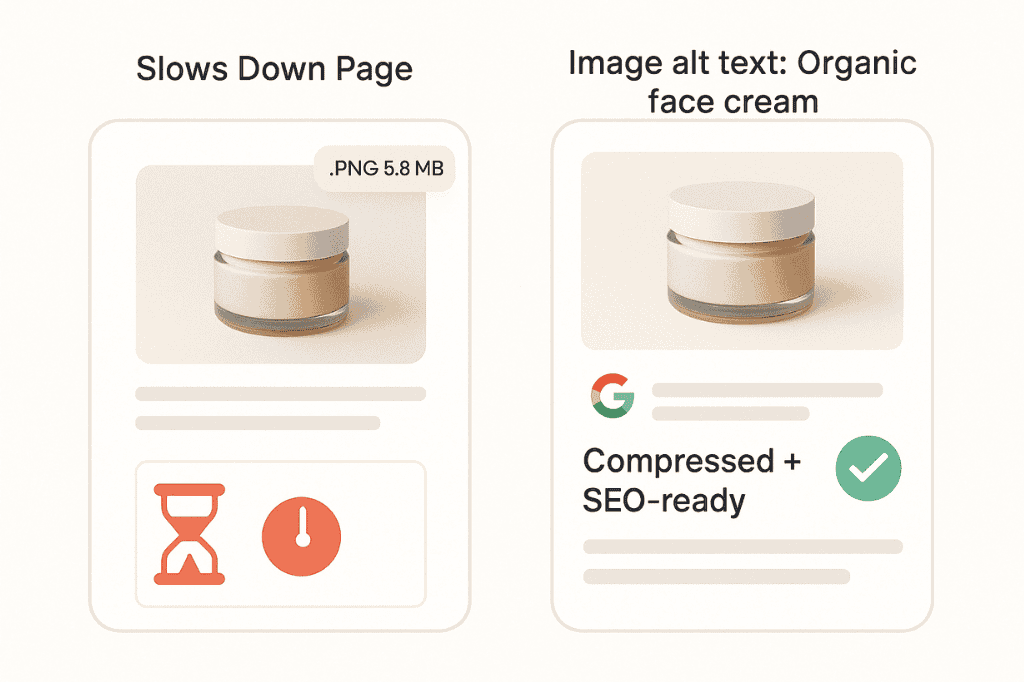
Shopify apps like TinyIMG can automate this for you.
4. Optimize Collection Pages — Not Just Products
Your collection pages are prime SEO real estate.
- Add a short intro with your target keyword
- Link to featured/best-selling items
- Keep content helpful and scannable
Think of collection pages like landing pages. Treat them with the same attention.
5. Fix Duplicate Content Issues
Shopify auto-generates multiple versions of the same page (especially with products in multiple collections).
- Use canonical tags to point Google to the main version
- Remove unnecessary duplicate URLs

Use a free SEO audit tool or ask us — we spot this fast.
6. Build Backlinks to Key Product and Collection Pages
Shopify makes link-building easy with blog integration.
- Write helpful blog posts related to your niche
- Link naturally to your products/collections
- Reach out to bloggers to feature you in gift guides or reviews
Add value first — people link to content that solves problems.
Shopify gives you the tools. SEO brings traffic.
If your Shopify store looks great but doesn’t get clicks, let ScaleeSEO step in.
We’ve helped store owners boost traffic, outrank competitors, and increase sales — without paid ads.
EO Tips for SaaS Business Owners
Selling software? Then you’re not just fighting for rankings — you’re fighting for trust.
In 2025, SEO for SaaS is all about solving problems, building authority, and turning visitors into free trial users or demos.
Here’s how to stand out in a crowded space:
1. Focus on Bottom-of-Funnel Keywords First
Many SaaS companies chase broad terms like “project management tools.”
But those are super competitive and often vague.
Instead, target buyer-ready keywords like:
- “Best project management software for remote teams”
- “Asana alternatives for agencies”
- “CRM with email automation for small business”
Go long-tail. These searches are lower in volume, higher in intent, and easier to rank for.
2. Create SEO-Optimized Feature Pages
Every key feature of your software should have its own page — optimised for search.
- Explain the problem it solves
- Use your keyword in the URL, H1, and first 100 words
- Add screenshots, use cases, and internal links to related features
These feature pages often outrank your homepage — make them strong.
3. Build Authority Through Educational Content
Blogging isn’t optional. It’s your SEO engine.
- Write about pain points your users face (e.g. “How to simplify team collaboration in remote work”)
- Include product mentions only when relevant
- Use internal links to drive traffic to feature and pricing pages
Build content clusters — one main topic page + multiple supporting blogs.
4. Optimize Pricing & Comparison Pages
Buyers compare. Make it easy for them.
- Create pages like:
/compare/yourtool-vs-competitor
/pricing
/yourtool-vs-alternative - Use structured data so Google understands your content
- Add FAQs and highlight USPs (unique selling points)
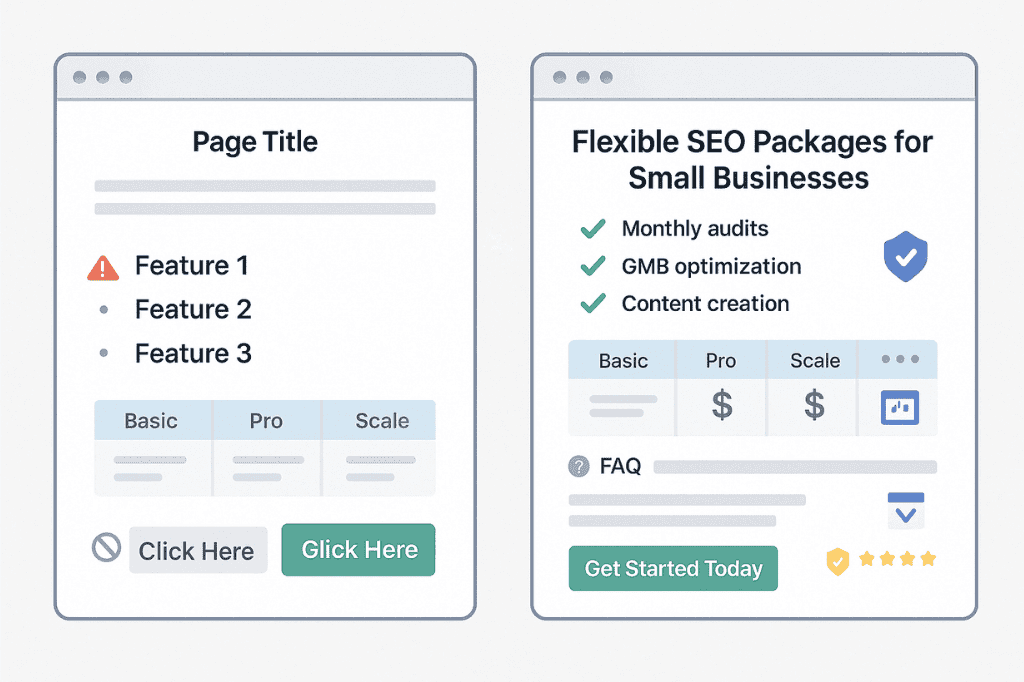
Comparison pages convert — and they rank surprisingly well.
5. Add Conversion Elements to High-Traffic Pages
Don’t just focus on traffic — turn it into revenue.
- Add “Start Free Trial” buttons above the fold
- Use exit popups with lead magnets (checklists, templates)
- Capture email with inline forms in blogs
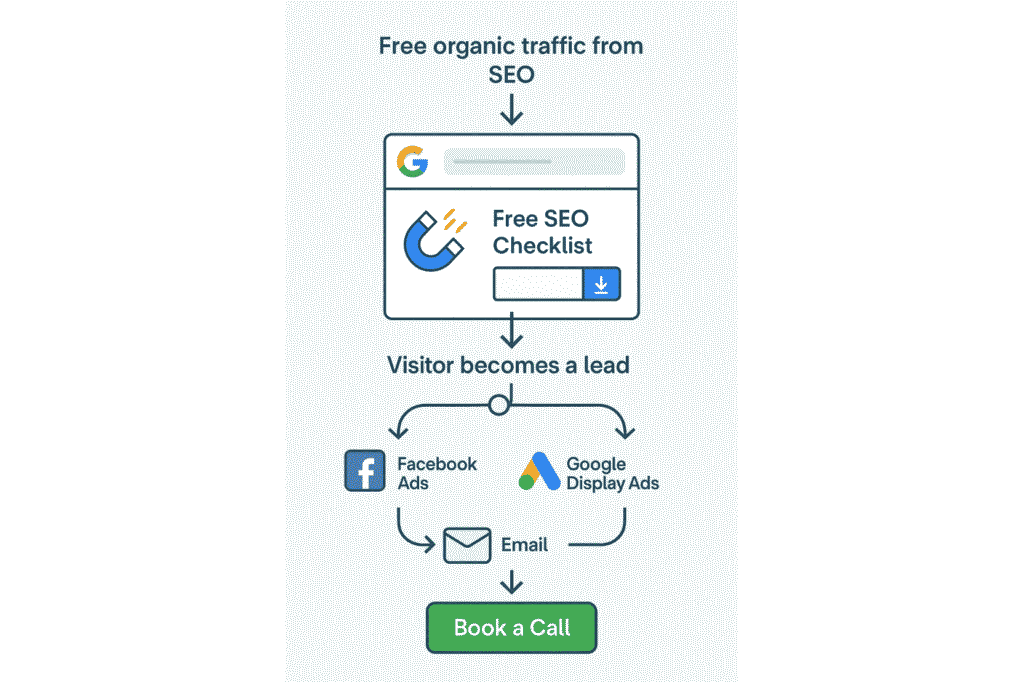
SEO brings the visitor. Your funnel should convert them.
SaaS SEO is technical, strategic, and full of growth potential — if you do it right.
SEO Tips for Health and Wellness Business Owners
If you run a health, wellness, or medical-related business — SEO is more than traffic.
It’s about credibility, visibility, and building trust before someone even contacts you.
In 2025, Google puts health content under a microscope — so here’s how to get it right:
1. Show Real Expertise with EEAT Signals
Health content is part of YMYL (Your Money or Your Life) — so Google expects more.
- Add your qualifications (on your About and Author pages)
- Link to credible sources in your blog posts
- Use real testimonials, reviews, and case studies

Your content needs to come from real experience — not ChatGPT-style fluff.
2. Optimize for Local SEO — People Search Nearby
Most people want wellness services near them.
Make sure they can find you.
- Create a full Google Business Profile with updated hours, photos, and categories
- Add location pages for each city/clinic you serve
- Collect and reply to patient/client reviews regularly
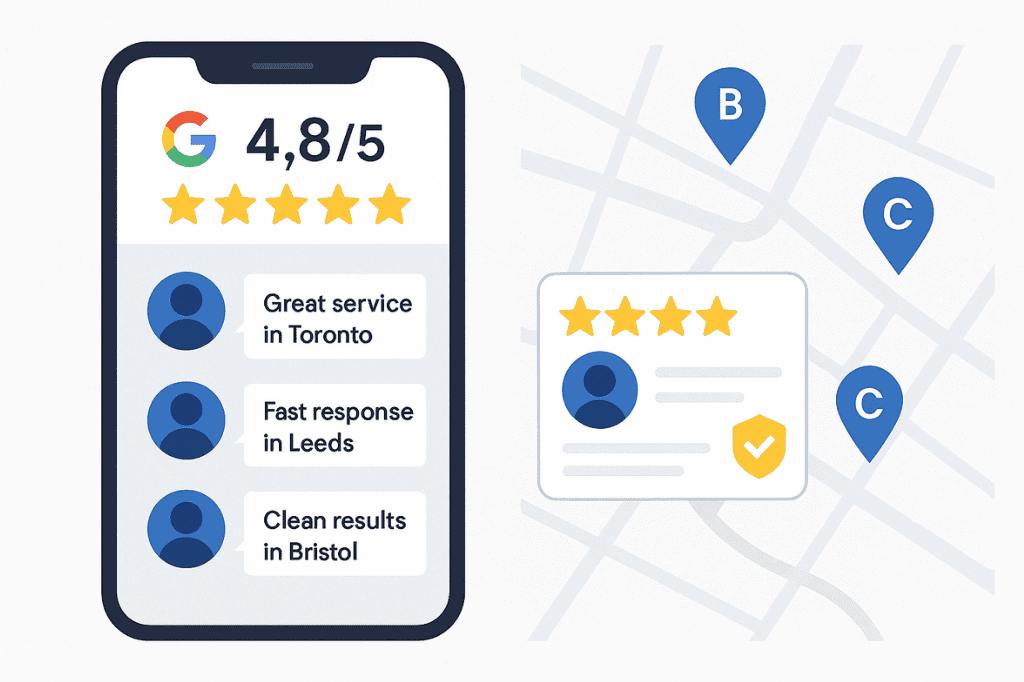
Use phrases like “nutritionist in Bristol” or “sports therapist near me” in your site copy.
3. Write Content That Answers Health Questions Clearly
People Google symptoms, treatment options, and recovery timelines daily.
Write about them in plain English — not in medical textbook language.
- Focus on “how,” “why,” and “what” style blog posts
- Include FAQs with clear answers
- Break up long content with headers and bullet points
Don’t over-promise or self-diagnose in your writing — stick to educating.
4. Secure Your Site — It’s a Trust Factor
If you’re collecting any client info (even a contact form), your site must be secure.
- Use HTTPS
- Add a clear privacy policy
- Make sure contact forms are GDPR/HIPAA compliant (where applicable)
Trust is the first step before a booking — don’t lose it with a dodgy-looking site.
5. Add Content for Every Service You Offer
If you’re a multi-service wellness brand (chiropractic, physiotherapy, massage, etc.) — break it up.
- One page per service = better rankings + clarity for users
- Add photos, benefits, and client stories to each page
- Use soft CTAs like “Book your free assessment” or “Talk to a specialist today”
Use schema markup for services — it helps Google display your info better in search.
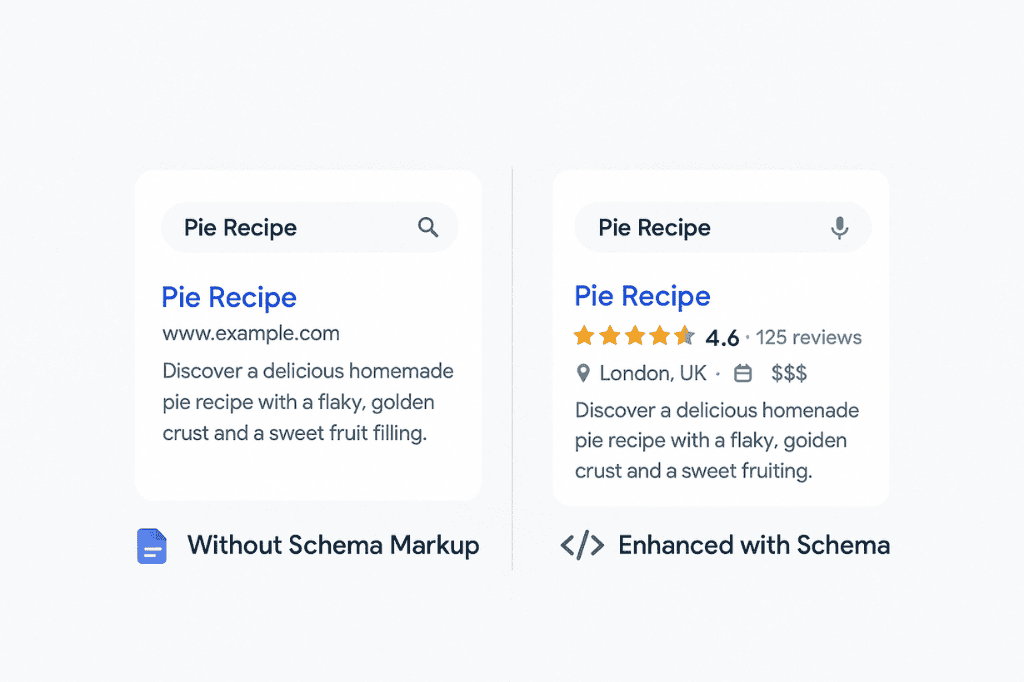
Your clients are searching for help.
Be the trusted result they find — and feel confident contacting.
SEO Tips for YouTube Channels / Video Creators
YouTube isn’t just a social platform — it’s the second-largest search engine in the world.
And if you’re not treating it like one? You’re missing serious traffic.
In 2025, YouTube SEO is about visibility + engagement.
That means showing up in search and keeping viewers watching.
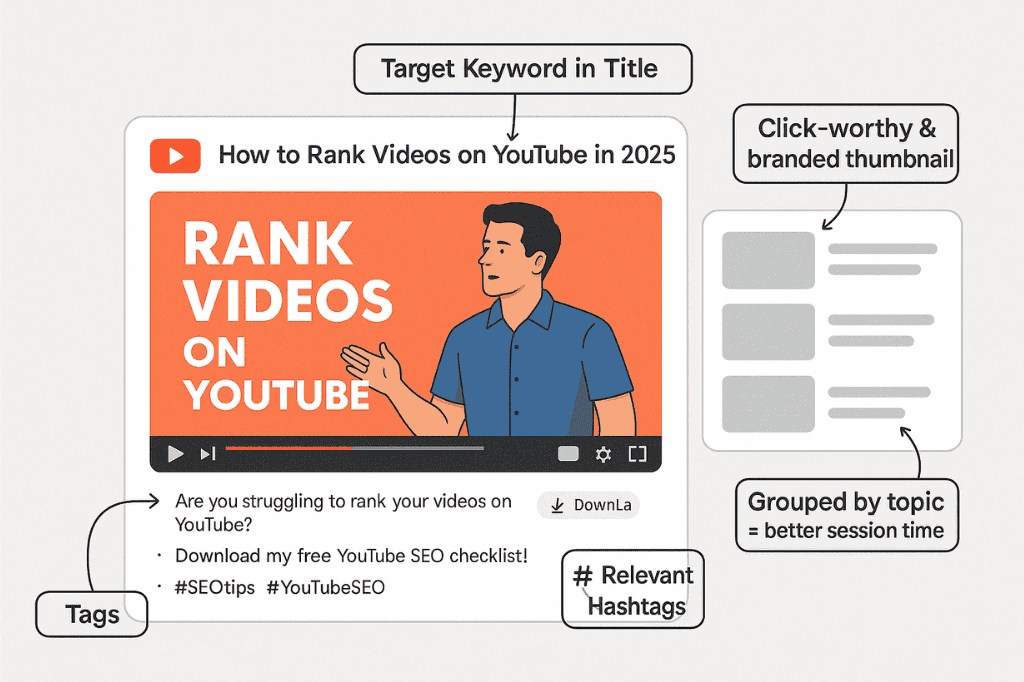
Here’s how to make your videos easier to find (and harder to ignore):
1. Start with Real Keyword Research — Before You Hit Record
Guessing your video title won’t cut it.
Use YouTube’s own data to find what people are searching for.
- Use tools like TubeBuddy, VidIQ, or even YouTube’s search bar suggestions
- Look at “related searches” and autocomplete
- Target keywords like: “how to…,” “best for…,” or “[your topic] explained”
Match search intent — don’t just copy trending titles.
2. Optimise Your Titles, Descriptions, and Tags
SEO doesn’t stop once you upload. It’s just getting started.
- Put your keyword at the start of the title
- Write a detailed description (150–300 words) with keywords, timestamps, and CTAs
- Add relevant tags (but don’t overdo it)
Add a call-to-action in the first 2 lines of the description — that’s what shows up in previews.
3. Use Custom Thumbnails That Make People Click
Your thumbnail = your first impression. And yes, it affects your rankings.
- Use bold text and high-contrast colors
- Make it click-worthy, not clickbait
- Keep it visually aligned with your brand

Add your keyword visually to the thumbnail — it helps reinforce your video’s topic.
4. Boost Watch Time with Structured Content
The longer people watch, the better you rank.
- Hook viewers in the first 10 seconds (promise value fast)
- Use timestamps (chapters) in your description
- Structure your video clearly: Intro → Value → Summary/CTA
Don’t ramble. Script your video or outline it tight before recording.
5. Organise Your Channel with Playlists
Playlists aren’t just for organization — they help with SEO.
- Group related videos into themed playlists
- Add keyword-rich descriptions to each playlist
- Link playlists internally (from your videos and channel homepage)
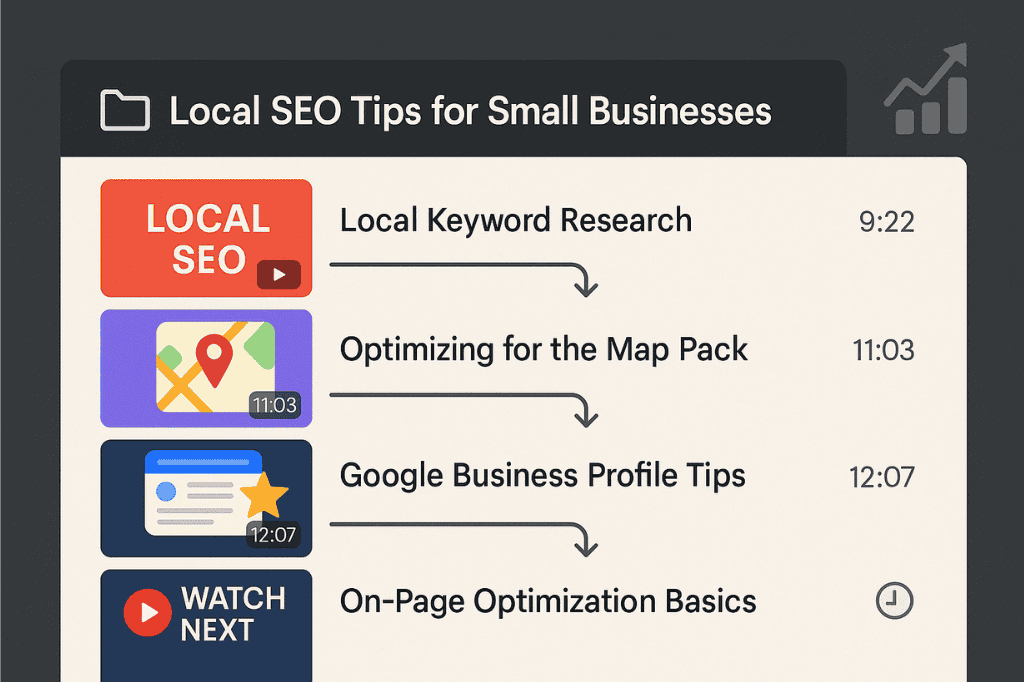
A well-structured playlist keeps viewers binge-watching — that’s gold for YouTube’s algorithm.
6. Promote Your Videos Off YouTube
Yes, YouTube ranks videos based on external engagement too.
- Share on your website or blog
- Embed in email newsletters
- Post on Reddit, Quora, LinkedIn — wherever your audience hangs out
Engagement in the first 24 hours is key — drive views early.
You don’t need fancy gear or viral hacks.
You need a repeatable system — and content that people actually search for.
SEO Tips for Book Authors
Writing the book is hard.
Getting people to find it online? That’s a whole different challenge.
Whether you’re self-published or working with a publisher, SEO can help you grow your audience, increase book sales, and build your author brand — without running ads.
Here’s how authors can use SEO to their advantage in 2025:
1. Build a Simple Author Website (and Optimise It)
If you don’t have a website, you’re invisible to search engines.
- Create a clean site with your name or book title as the domain
- Include core pages: About, Books, Blog, Contact
- Optimise your homepage with your genre, niche, and author bio
Use your name + genre together — “Jane Smith | Mystery Author” — in your title tag.
2. Create Dedicated Pages for Each Book
Don’t just list your books on one page. Give each book its own spotlight.
- Use SEO-friendly URLs like /books/the-final-code
- Add a summary, reviews, cover image, and “Buy” links
- Include keywords like “thriller novel,” “best fiction for teens,” etc.
Add FAQs about the book — it helps with rankings and rich snippets.
3. Blog Around Your Genre or Writing Themes
Google rewards fresh content — blogging helps you stay relevant.
- Share behind-the-scenes stories, writing tips, or character backstories
- Answer reader questions like:
“How long does it take to write a book?”
“What inspired [Book Title]?” - Include internal links to your book pages
Readers love connection. Use your blog to build it — while improving SEO.
4. Use Amazon SEO for Better Marketplace Visibility
Your Amazon page is searchable too — inside and outside Google.
- Optimise your book title and subtitle with keywords
- Add relevant categories and backend keywords
- Use a strong, keyword-driven description that sells

Check what similar books are ranking for — and adapt your phrasing.
5. Get Backlinks Through Interviews and Guest Posts
Backlinks = authority. And authors have a great excuse to get them.
- Reach out to book bloggers, podcasters, and local media
- Offer to guest post on writing sites
- Get featured in “Top Books of the Year” or genre roundups
Link back to your author site or book page — not just your Amazon listing.
SEO isn’t just for marketers — it’s for storytellers who want to be discovered.
SEO Tips for Etsy Store Owners
Selling on Etsy? Then you already know — it’s crowded.
But here’s the thing: you don’t need to beat everyone — just be found by the right buyers.
In 2025, Etsy SEO is all about visibility inside Etsy and attracting traffic from outside platforms like Google and Pinterest.
Here’s how to stand out (without running ads every day):
1. Use Long-Tail Keywords in Titles (Naturally)
Shoppers search using specific terms like:
“boho wedding earrings”
“personalised dog tag collar”
“handmade candle for anxiety”
- Add these naturally in your title — front-load the most important phrase
- Avoid keyword stuffing — make it readable
Think like a buyer. What would you type to find your product?
2. Write Clear, Keyword-Rich Product Descriptions
Etsy uses your descriptions for SEO signals too.
- Describe benefits, not just features
- Include keywords naturally in the first paragraph
- Mention variations, materials, and use-cases
Use your most relevant keyword 2–3 times, but keep it human.
3. Optimise Product Tags and Categories
You get 13 tags. Don’t waste them.
- Use a mix of broad and specific keywords
- Include synonyms and alternate spellings
- Don’t repeat what’s already in your title
Tags help Etsy understand your listing — better tags = better placement.
4. Bring in Traffic from Google and Pinterest
Don’t just rely on Etsy’s search engine.
- Write blog posts or how-to guides on your own site
- Pin product images to Pinterest with keyword-rich descriptions
- Get backlinks from blogs or influencers in your niche
Etsy ranks better when listings get clicks from outside the platform.
5. Keep Your Shop Active and Updated
Etsy’s algorithm favours shops that stay active.
- Add new listings regularly
- Update older listings with new photos, tags, or descriptions
- Reply to reviews and messages quickly
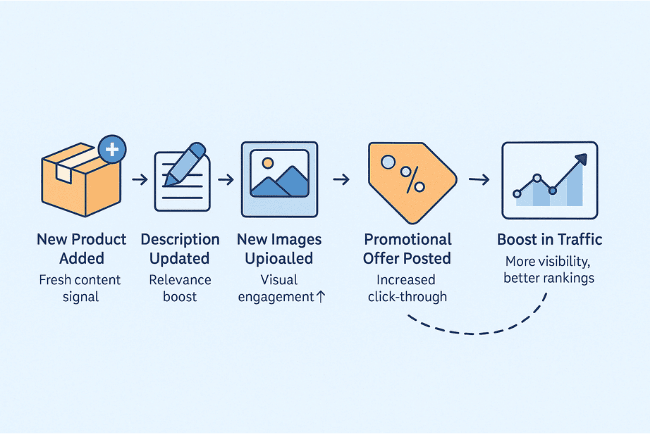
Even minor updates signal freshness to Etsy.
Your handmade product might be amazing.
But if no one finds it — it doesn’t sell.
Want to rank your Etsy store higher and get consistent sales — organically?
Let ScaleeSEO help you drive traffic from both Etsy and Google — so you can focus on creating.
SEO Tips for Bloggers
Blogging in 2025 is more competitive than ever — but still incredibly powerful.
If you’re writing without SEO, you’re basically whispering into the void.
Here’s how to make sure your content gets seen, ranks well, and keeps bringing in traffic long after you hit publish.
1. Choose Topics Based on Search Intent, Not Just Passion
Writing what you want isn’t enough.
You need to write what people are actively searching for.
- Use tools like LowFruits, Google Trends, and Search Console
- Target questions, problems, and “how-to” phrases
- Group related topics under one theme (aka content clusters)
Start with low-competition keywords — they rank faster and bring targeted traffic.
2. Organize Your Blog with Topic Clusters
Google loves structure. And so do readers.
- Choose a core topic (pillar), then write supporting blogs around it
- Internally link them all together
- Example:
Pillar: “How to Start a Gardening Blog”
Support: “Best SEO Tools for Bloggers,” “How to Monetise Blog Traffic,” “Mistakes to Avoid in Year One”

This builds topical authority — and keeps people on your site longer.
3. Format for Skimmability and UX
Even the best content will fail if it looks like a wall of text.
- Use short paragraphs and clear subheadings (H2, H3)
- Add bullet points, numbered lists, and visuals
- Use bold to highlight important points
People scroll before they read. Help them find what they need — fast.
4. Update Old Blog Posts Regularly
What worked in 2022 may not rank in 2025.
- Refresh outdated info and stats
- Improve internal linking
- Re-optimise your meta title and headings
- Add new images, FAQs, or examples
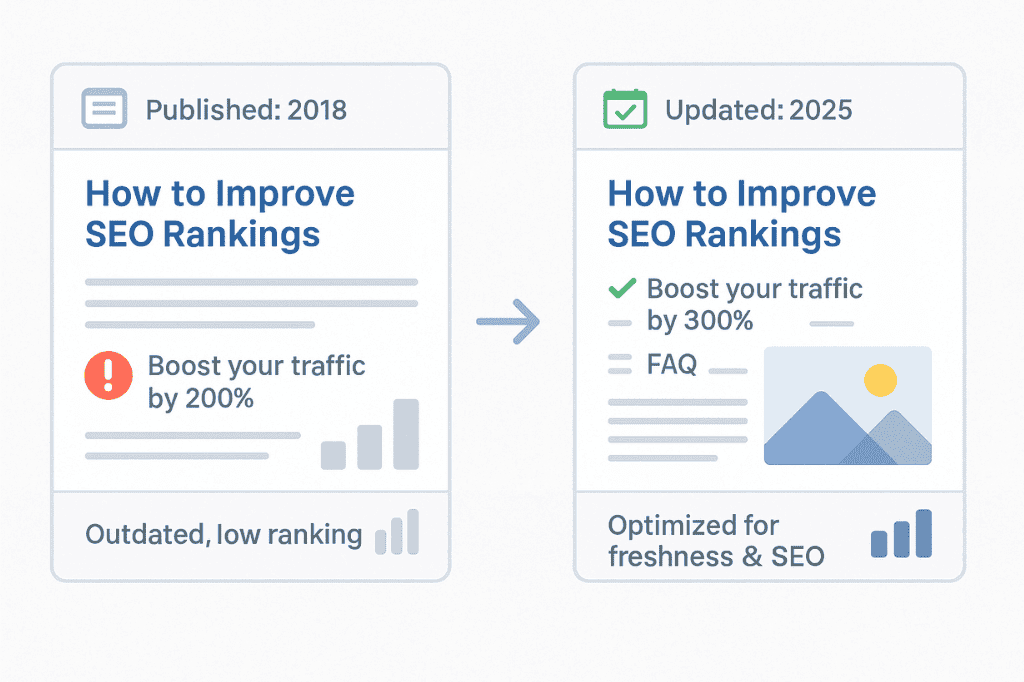
Google loves fresh content — and updates can boost rankings fast.
5. Build Backlinks to Key Posts (Strategically)
Bloggers often overlook link building. Big mistake.
- Reach out to niche blogs for guest posts
- Answer questions on Quora/Reddit and link to your content
- Create linkable assets like tools, templates, or infographics
Quality > quantity. One strong backlink can outrank 10 weak ones.
You don’t need to be a tech wizard.
You just need to write with purpose — and optimise with clarity.
Want your blog to finally get the traffic it deserves?
Let our team help you plan, structure, and grow your blog with SEO strategies that actually work.
SEO Tips for Service-Based Businesses
If your business sells a service, not a product — SEO is your silent sales rep.
It helps you show up when someone types:
“Roof repair in Bristol”
“Mobile dog grooming near me”
“Online career coaching for students”
In 2025, it’s not about doing more. It’s about doing what works.
Here’s how to do SEO right as a service provider:
1. Create a Dedicated Page for Each Service You Offer
Too many businesses put all services on one page.
That’s confusing for Google — and for your visitors.
Do this:
- /services/house-cleaning
- /services/end-of-tenancy-cleaning
- /services/office-cleaning
Not this:
- /services

One service = one page = one opportunity to rank.
2. Target Local Keywords (Even If You Offer Remote Services)
Whether you serve clients in person or online, local intent helps build trust.
- Use keywords like: “web designer in Manchester” or “virtual assistant UK”
- Add your city/town name naturally in page titles, content, and image names
- Optimise your Google Business Profile — even if you work from home
Include service area maps or city-specific FAQs on your site.
3. Add Real Trust Signals Throughout Your Website
People won’t call unless they trust you.
- Add testimonials and star ratings on key pages
- Include logos of clients, case studies, or certifications
- Display social proof — “150+ clients served” or “Rated 4.9 on Google”
Trust isn’t built by fancy design. It’s built by proof.
4. Make Navigation & Booking Stupid-Simple
Don’t make people hunt for your number or fill out a 12-step form.
- Use clear CTAs: “Call Now,” “Book Your Free Quote,” “Schedule a Consultation”
- Add buttons above the fold (especially on mobile)
- Offer multiple contact options: phone, email, booking form
Every extra click = lost leads. Streamline the path to action.
5. Write Blogs That Answer Pre-Sale Questions
Think of your blog as your virtual sales assistant.
- Write about pricing breakdowns, service comparisons, and what to expect
- Examples:
“Deep Cleaning vs Regular Cleaning — What’s Right for You?”
“How to Prepare Your Home Before a Carpet Cleaning Visit” - Include CTAs to your service pages throughout
Educate first — sell second. Trust converts better than pressure.
You’re in the business of helping people.
Let SEO make sure they actually find you first.
SEO Tips for Coaches, Consultants & Freelancers
You are your brand.
And in 2025, if people can’t find you — they won’t hire you.
Whether you’re a business coach, marketing consultant, or freelance designer, SEO helps you attract dream clients without chasing them.
Here’s how to use search to your advantage:
1. Build a Personal Brand Site That Actually Converts
Don’t rely on social media profiles alone. You need a site that’s built to rank and convert.
- Use your full name or niche in your domain (e.g., sarahjcoaching.com)
- Create separate pages for: About, Services, Case Studies, Contact
- Add your photo — people trust faces
Use your homepage to clearly explain who you help and how you help them.
2. Target Problem-Solving Keywords in Your Niche
Don’t try to rank for “coach” — way too broad.
Instead, focus on what your audience is searching for right now.
Examples:
- “Time management coach for busy moms”
- “Marketing strategy for SaaS startups”
- “Freelance UX designer for fintech companies”
Long-tail keywords convert higher — because they match intent perfectly.
3. Create Helpful Content That Builds Authority
Position yourself as the go-to expert.
- Write blog posts answering common client questions
- Share case studies, frameworks, or downloadable guides
- Use internal links to drive traffic to service or booking pages
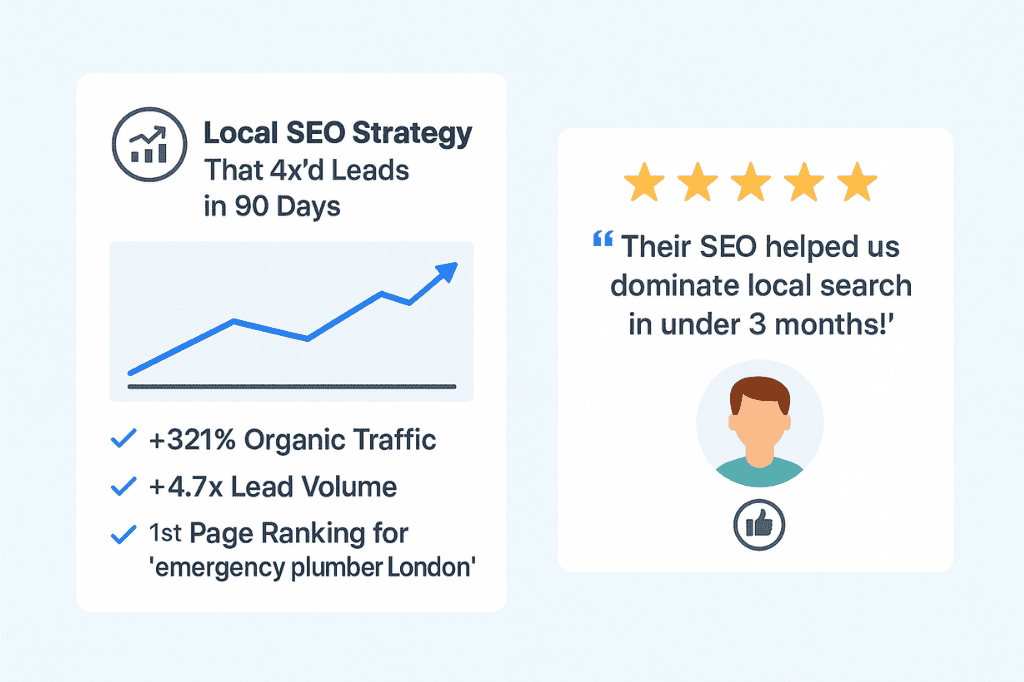
Teach what you know — and make it clear how to take the next step with you.
4. Optimise Your Service Page Like a Landing Page
Your service page isn’t just for info — it’s where conversions happen.
- Use benefit-driven headlines
- Add a short bio and proof of expertise
- Include testimonials and FAQs
- End with a strong CTA like “Book a Free Strategy Call”
Embed a calendar (Calendly or similar) for seamless booking.
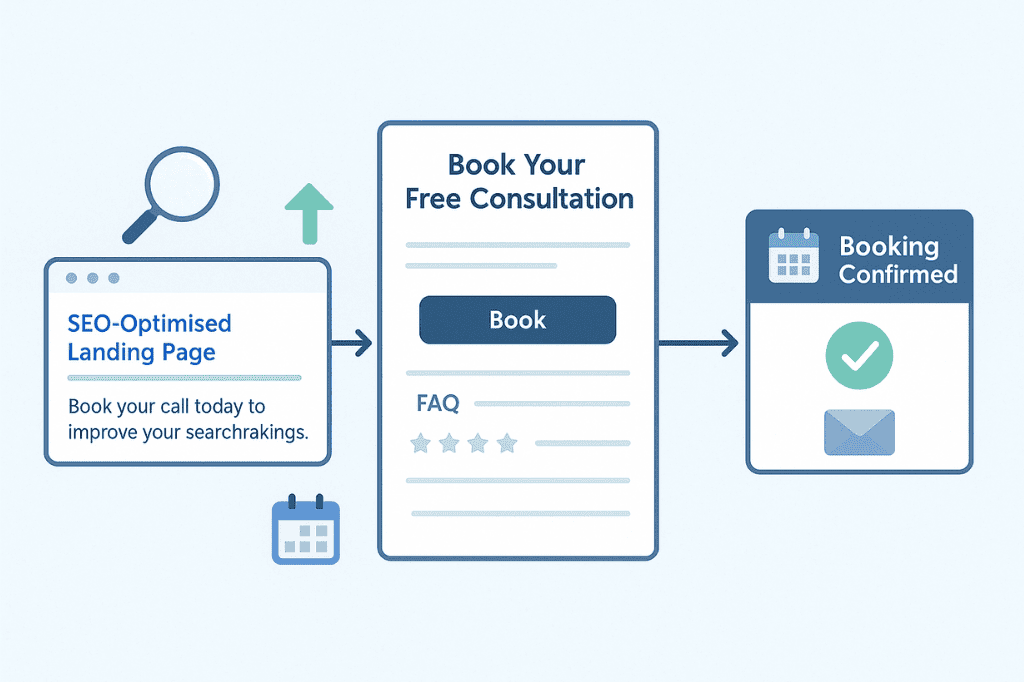
5. Get Backlinks by Sharing Your Knowledge
As a coach or consultant, you have something valuable: insights.
Use that to get featured.
- Guest post on niche blogs or industry publications
- Get interviewed on podcasts or LinkedIn Lives
- Create shareable resources (e.g. checklists, templates)
Every quality backlink builds your authority — and your Google trust score.
You’re not selling a product — you’re selling transformation.
Make sure you’re the first one people find when they’re ready to grow.
SEO Tips for Online Course Creators
You created an online course to teach what you know — now it’s time to make sure people actually find it.
Whether you’re using Teachable, Kajabi, Thinkific, or hosting on your own site, SEO is one of the most cost-effective ways to drive organic traffic, build authority, and sell courses 24/7.
Here’s how to get results in 2025:
1. Create a Course Landing Page That Ranks and Sells
Don’t rely on platform pages alone. You need a page that’s built for search and conversion.
- Include your course title + primary keyword in the URL (e.g., /courses/instagram-marketing-for-beginners)
- Add a clear H1 headline focused on outcome
- Break down modules, bonuses, and benefits
- Use testimonials and student results
Answer FAQs directly on the page — it helps with SEO and overcomes objections.
2. Target Buyer-Intent Keywords — Not Just “How-To” Terms
Many course creators rank for tips, but miss keywords with purchase intent.
Go for terms like:
- “Best Instagram marketing course for small business”
- “Learn Excel formulas online with certificate”
- “Course to become a freelance copywriter”
These may have lower volume, but they’re full of buyers ready to learn.
3. Blog Around Student Pain Points and Questions
Your blog is your best inbound sales funnel.
- Write helpful guides and beginner posts that link to your course
- Example:
📝 “How I Grew from 0 to 10K Followers Without Ads”
📝 “3 Mistakes to Avoid When Launching Your Freelance Business” - Use internal linking to push traffic to your course page
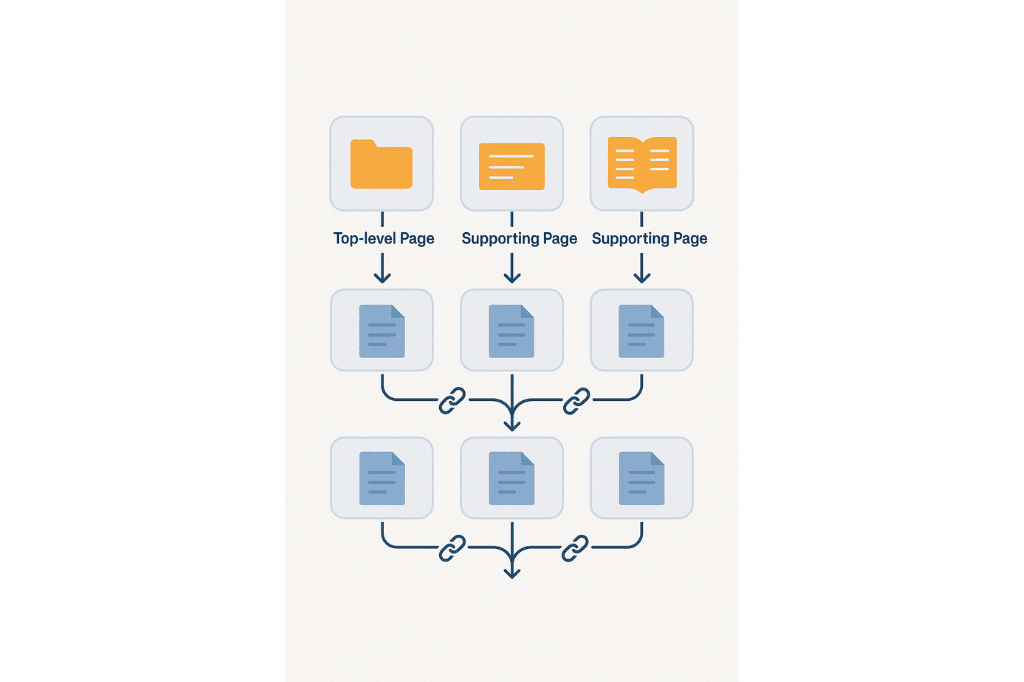
Don’t just teach in your course — teach a preview in your blog.
4. Optimise Visual Content for Search (and Shares)
Visuals help you rank and convert.
- Create SEO-friendly video titles and descriptions if you post on YouTube
- Embed short video explainers or teasers on your landing page
- Add alt text to all course images
Google indexes video transcripts too — use that to your advantage.
5. Build Links and Authority Through Thought Leadership
Google won’t rank your course without authority. Build it smart.
- Write guest posts on education, startup, or niche industry blogs
- Partner with influencers or newsletters in your space
- Share insights or mini-lessons on LinkedIn or Reddit with backlinks
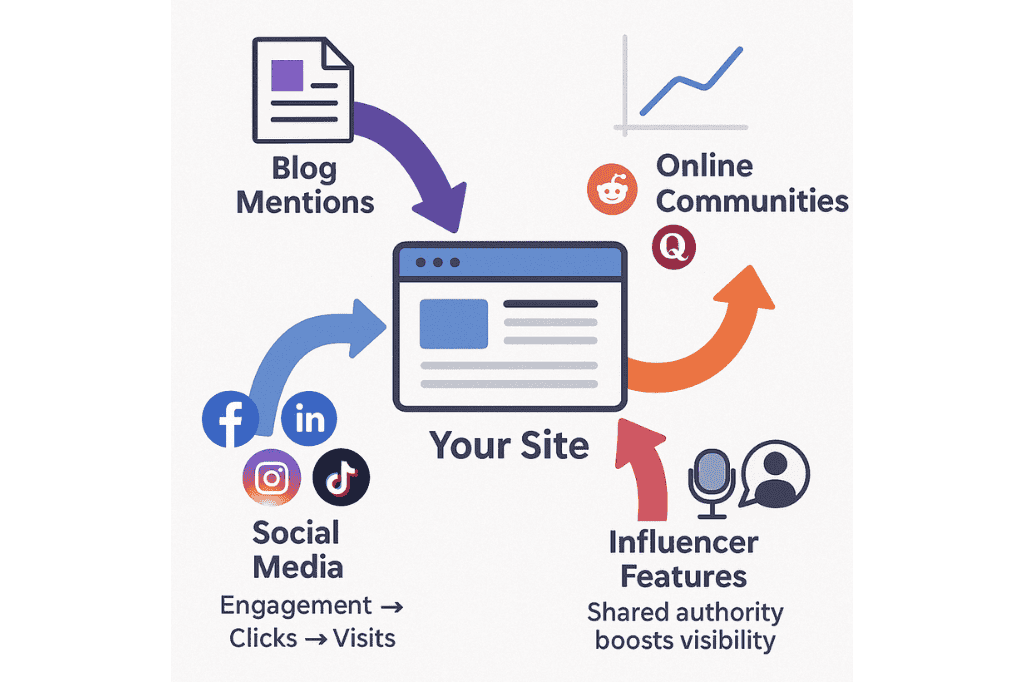
Just one high-quality backlink to your course page can give it a serious ranking boost.
Selling your course shouldn’t rely on paid ads forever.
With the right SEO, you build a long-term, traffic-generating machine.
Most Common SEO Mistakes Business Owners Still Make (in 2025)
By now, you’ve seen what to do.
But here’s the thing — most businesses are still stuck making basic SEO mistakes that cost them traffic, leads, and sales.
Here’s what to avoid if you want your SEO to actually work in 2025:
1. Focusing Only on Rankings, Not Intent
Ranking for a keyword doesn’t mean you’ll get the right clicks.
- Don’t chase vanity keywords that don’t convert
- Instead, target specific, action-driven phrases your audience actually types
Ask yourself — does this keyword match what my ideal customer is looking for right now?
2. Ignoring Technical SEO
If your site loads slow, has broken links, or isn’t mobile-friendly — you’re losing visitors and rankings.
Run a quick audit with tools like Screaming Frog, Ahrefs, or PageSpeed Insights — or have us do it for you.
3. Using the Same Strategy for Every Platform
Shopify isn’t WordPress. SaaS isn’t Etsy.
Each platform and business type needs its own strategy.
Tailor your SEO based on how your customers search — not a one-size-fits-all approach.
4. Writing for Google, Not People
Keyword stuffing? Robot-speak? Long intros that say nothing?
Stop.
Write content that helps the user first, then optimise it to help Google understand it.
5. Doing Everything Yourself (and Doing It Wrong)
We get it — you’re busy. But SEO done wrong is worse than not doing it at all.
Focus on what you do best — and let experts handle what we do best.
Why DIY SEO Has Its Limits
Yes, there are free tools.
Yes, you can Google your way into the basics.
But…
- You won’t spot critical issues that kill your traffic
- You’ll miss out on the fastest growth opportunities
- You’ll waste time trying to fix what you don’t fully understand
Result?
No traffic. No leads. No ROI.
SEO isn’t just a marketing tactic — it’s your digital foundation.
Let ScaleeSEO Do It Right — From Day One
We’ve been doing this for 5+ years across the UK, USA, Canada, Ireland, and Wales — generating millions in revenue for businesses just like yours.
→SEO that matches buyer intent
→Google Ads that convert without draining your budget
→Copy that sells without sounding “salesy”
→Lead generation strategies that don’t waste your time
Let’s Talk. Your Business Deserves Real Results.
Ready to stop guessing and start growing?
Book your free strategy call with ScaleeSEO now
Let’s build something that scales.



